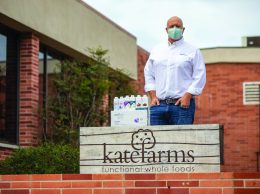Inogen gets FDA approval for at-home oxygen device
IN THIS ARTICLE
- Health Care & Life Science Topic
- Staff Report Author
By Staff Report Tuesday, June 24th, 2014

From left, Inogen founders Byron Myers, Alison Bauerlein and Brenton Taylor (courtesy photo)
Goleta-based Inogen said it has received approval from the U.S. Food and Drug Administration to sell a stationary oxygen concentrator.
Inogen, a UC Santa Barbara spinout that went public earlier this year, has experienced rapid growth by selling a portable oxygen concentrator called the Inogen One that is lighter and easier to maintain than tank-based systems. The company said its new stationary device, called Inogen At Home, will be released later this year and will weigh only 18 pounds, a full 10 to 20 pounds lighter than competing systems.
“Inogen set out to change the oxygen therapy market with our Inogen One family of products, and in a similar fashion with the Inogen At Home, we intend to change the perception of oxygen concentrators used in the home,” Raymond Huggenberger, Inogen’s CEO, said in a statement.
An at-home device would let the company capture more business from patients on Medicare, which Inogen believes covers about 60 percent of all oxygen therapy patients. Inogen bills the federal government under two Medicare reimbursement codes: E1390, which is for stationary oxygen systems, and E1392 for portable systems. For its portable system, Inogen bills under the two codes under the assumption that patients who qualify for portable oxygen systems also use the systems at home in a stationary manner.
But about a third of patients only require oxygen at night, meaning they only qualify for the E1390 stationary system code. Inogen said the at-home system should help it compete for those customers with “a compelling solution for nocturnal-only oxygen therapy patients that do not yet require a portable solution, which are estimated to represent 30 percent of total oxygen patients in the United States.”
Inogen’s shares have been rising steadily since mid-May, when the company announced stong first-quarter results and boosted its sales outlook for the rest of the year. Profits for the first quarter were $900,000, or about 5 cents per share, beating Wall Street’s expectations of 4 cents per share. First-quarter sales were $23.6 million, a more than 50 percent increase from the year before. Inogen raised its revenue forecast to $92 million to $96 million for 2014, up from a previous estimate of $90 million to $94 million.
Investors also appear pleased with how Inogen has handled changes in Medicare’s reimbursement regime. The federal government implemented a competitive bidding process for oxygen system rental reimbursements.
In the first quarter, Inogen’s rental revenue was $8.8 million. The number of rental patients was up 49.4 percent, compared to the year before, but rental revenue was up only 28.1 percent because of rental reimbursement rate reductions from Medicare. But Inogen’s margins for those patients held steady.
“Despite these significant year-over-year declines in rental reimbursement rates, our gross margin was 50.5 percent in the first quarter of 2014, and was just 100 basis points lower than the 51.5 percent reported in the 2013 period,” the company said.
Inogen’s stock was up more than 5 percent to $20.15 during midday trading on June 24 after the new product was announced.
Related Articles
 Friday, September 30th, 2022
Friday, September 30th, 2022
In the region and the nation, women get a tiny share of venture capital dollars
 Monday, September 19th, 2022
Monday, September 19th, 2022










